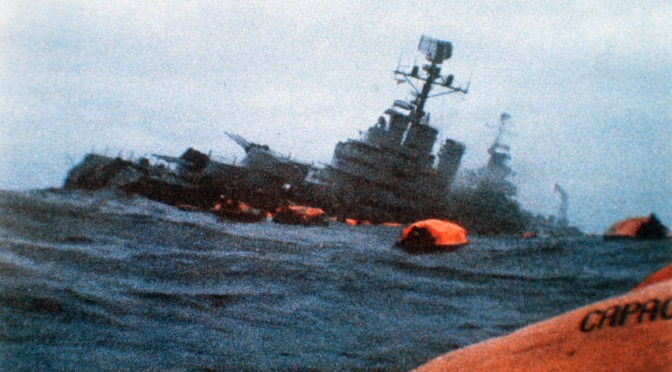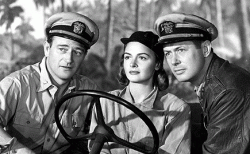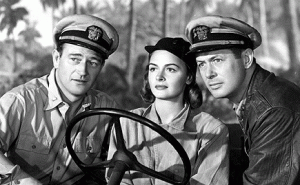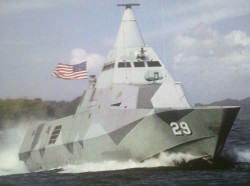LT Jimmy Drennan is a Surface Warfare Officer in the U.S. Navy. He is the prospective Weapons Officer aboard USS Gettysburg and a Distinguished Graduate of the Naval Postgraduate School’s Systems Engineering Analysis program.
You are a tactical commander tasked with a mission to seek out and destroy one of the enemy’s premier capital ships in his home waters. You have two potential striking forces at your disposal: a world class surface combatant of your own with a 99% probability of mission success (Ps = 0.99) or a squadron of eight independently operating, missile carrying small combatants – each with a chance of successfully completing the mission no better than a coin flip (Ps = 0.5). Do you go with the almost sure thing and choose to send in your large combatant? As it turns out, the squadron of small combatants has an even higher overall Ps. But let’s assume now that you’ve advanced to operational commander. You might have more concerns than just overall Ps. What are the defensive and logistical requirements for each option? How much fleet investment am I risking with each option? What will it cost to replace the asset(s) if it is lost? What capability does the striking force have after successful enemy action (i.e. resilience)? An analysis of these factors, intentionally designed to disadvantage the small combatants, actually comes out overwhelmingly in their favor over the large combatant. The results verify what naval strategists and tacticians have long known: for certain offensive missions, an independently operating group of even marginally capable platforms can outperform a single large combatant at lower cost and less risk to the mission.
The War at Sea Flotilla: A Test Case
In the Autumn 2012 edition of the Naval War College Review, Captains (U.S. Navy, Retired) Jeff Kline and Wayne Hughes introduce “A War at Sea Strategy” in which they describe a flotilla of small, missile-carrying surface combatants designed to challenge Chinese aggression in East Asian waters. The flotilla ships would utilize largely independent tactics, relying little on networked command and control, to produce a powerful cumulative combat capability.
“What would the flotilla look like? In rough terms, we envision individual small combatants of about six hundred tons carrying six or eight surface-to-surface missiles and depending on soft kill and point defense for survival, aided by offboard manned or unmanned aerial vehicles for surveillance and tactical scouting. To paint a picture of possible structures, we contemplate as the smallest element a mutually supporting pair, a squadron to comprise eight vessels, and the entire force to be eight squadrons, of which half would be in East Asian waters. The units costing less than $100 million each, the entire force would require a very small part of the shipbuilding budget (Hughes and Kline, 2012).”
This flotilla concept provides an ideal test case to compare against a world class surface combatant but first we must establish a few key assumptions on which this analysis is based.
Statistical Independence. The math behind this analysis hinges on the idea that the outcome of one small combatant’s engagement has no effect on the others in the squadron. While true statistical independence is nearly impossible to achieve in real world naval operations, the War at Sea Flotilla concept models it closely with independently operating units, the potential for various ship classes, and the inclusion of allied navies which may use different tactics, techniques, and procedures (TTPs). This concept of operations is a major departure from today’s heavily networked forces which generate combat power through the integrated actions of several units. In those forces, the actions of one unit can have profound impact on the effectiveness of another.
Defensive and Logistical Requirements. For the purposes of this analysis, we will assume that the defensive and logistical requirements are roughly equivalent for both the small combatant squadron and the large combatant. Both would require defensive support in warfare areas not directly related to the current mission. Even a multi-mission, blue water combatant would employ inorganic support, such as maritime patrol aircraft or early warning assets, to watch its back while it conducted a focused offensive mission. As for logistics, any surface asset would need an oiler nearby to conduct sustained operations in enemy waters. A nuclear powered aircraft carrier would still require periodic support to replenish its stores of jet fuel. The logistics tail would be shorter for a large combatant than a flotilla, since it carries much of its own maintenance and supply support, but that can be a detriment in a mission involving an exchange of missile salvos. While the structure of defensive and logistical support may differ greatly between the flotilla and the large combatant, one can assume the drain on resources would be about the same for both options.
Unit Cost. Captains Hughes and Kline estimate the unit cost of the flotilla small combatants at $80 million (Hughes and Kline, 2012). Therefore, a squadron of eight combatants would cost $640 million. The unit cost of the large combatant is assumed to be $1 billion, which is an underestimate for relevant US Navy platforms. The cost estimates in this analysis are intentionally set up to work against the flotilla concept in order to emphasize its potential for savings.
Enemy Capabilities. To further disadvantage the flotilla concept, let’s assume the small combatants are significantly overmatched by the enemy combatant. In a first strike, the enemy combatant is capable of simultaneously targeting six of the eight squadron combatants. Against the large combatant, it is capable of conducting a devastating mission kill in which the ship may not be sunk but the cost to repair it to fully mission capable would be comparable to the unit cost. As a starting argument, let’s assume in either case the enemy can achieve a mission kill with 10% probability (Pmk =0.10) since both striking forces have similar levels of defensive support. You might argue that Pmk should be lower for the large combatant because it possesses superior self defense capabilities; however, you could also argue that the mobile, distributed nature of the small combatant squadron compensates for each ship’s lack of self defense by complicating the enemy’s targeting process. It may be relatively easy for the enemy to target one or two of the small combatants, but it remains a challenge to simultaneously eliminate the entire squadron.
Selecting the Right Striking Force: Analysis Results
Using the generic introductory scenario, we can compare the small combatant squadron to the large combatant in terms of performance, cost, and risk.
Overall Effectiveness. We are given the overall effectiveness of the large combatant as Ps = 0.99 and the individual effectiveness of the small combatants as Ps,ship = 0.5. To determine the overall effectiveness of the squadron, it is easiest to first estimate the probability that none of the small combatants successfully accomplish their mission. The probability that any one small combatant will not accomplish the mission is,
Since the outcomes of each engagement are estimated as independent of one another, the probability that none of the eight small combatants accomplish the mission is,
The probability that at least one of the small combatants accomplish the mission is the converse of the previous result, or
In other words, the squadron has a 99.6% probability of success vice 99% for the large combatant. This may not seem like much of an improvement, but it is more remarkable when considering the unit cost of each option.
Cost Effectiveness. The unit costs are given as $1 billion for the large combatant and $80 million for the small combatant, so we know that the squadron of eight small combatants is the more affordable option at $640 million. In addition, we have established that the squadron can outperform the large combatant for this particular offensive mission in which the individual squadron ships are actually overmatched by the enemy. The squadron is not only more cost effective than the large combatant; it actually delivers better performance at lower cost. As a commander, would you rather invest $1 billion in striking force that fails 10 times in 1000 attempts, or save $360 million with a striking force that fails only 4 times in 1000 attempts? To put it another way, if you were to invest the same $1 billion in 12 small combatants, you could deliver a striking force that failed only 2 times in 10,000 attempts (Ps = 0.9998).
Resilience after Enemy Action. One way to consider risk is to look at the impact to the mission if the enemy is able to successfully consummate a first attack. We have assumed the enemy is equally capable of attacking the large combatant and the squadron of small combatants. If the enemy combatant achieves a simultaneous mission kill against six of the small combatants, then only two will remain to continue the mission. These two small combatants have a combined 75% probability of successfully completing the mission. On the other hand, if the enemy successfully conducts a mission kill against the large combatant, the probability of successfully completing the mission is 0% and you lose the other warfare area capabilities that the large combatant could bring to bear in other missions. The additional investment required to provide onboard logistics support is also lost.
Another way to look at this risk is to calculate the expected damage cost of each option in the long run. Assuming the enemy is able to conduct devastating mission kills (in which the repair costs are comparable to the unit cost) a conservative 10% of the time (Pmk = 0.1) for both the large and small combatants, then the expected damage cost for the large combatant is,
Likewise, the expected damage cost for the squadron of small combatants is,
In the long run, the enemy is expected to cause $52M less damage per mission in the case of the small combatants. Even if the enemy were more likely to successfully target six small combatants simultaneously, how much would you as a commander be willing to pay for 75% follow-on capability vice 0%?
Less Communications, Less Cost, More Combat Power: Analysis Insights
The results of this analysis seem to indicate that the squadron of small combatants is an obvious choice for naval missions involving direct action against the enemy fleet. Yet the scenario described is quite generic and says nothing about the actual TTPs and systems the squadron will utilize in prosecuting the enemy. How can such a generic scenario really prove anything about the effectiveness of small combatants? The key is that two fundamental principles underlie this analysis and can be applied in much broader terms.
First, independently operating, redundant, and at least marginally capable units will greatly increase any system’s overall effectiveness, primarily because unit faults and errors are not permitted to propagate through the system as they would in net centric warfare (e.g. flawed group tactics or a false link track). For surface combatants, an individual effectiveness of 50% is sufficient to affordably produce a formidable striking force. For less expensive systems, that number may be even less. Ultimately, this kind of system is so effective because it is highly unlikely that none of the individual units will successfully complete the mission.
The second principle that contributes to the appeal of the small combatant squadron is that the price of military systems increases exponentially as you attempt to improve individual unit performance closer and closer to perfection. Most of our warships today are designed well past the “knee” in the cost curve. Small combatants can be built with marginal capability at (relatively) very low cost. One new concept illustrates how less capable ships can affordably produce equivalent performance as more capable ones in certain situations. In his 2009 essay, “Buy Fords, Not Ferraris” Captain (U.S. Navy) Henry Hendrix proposes Influence Squadrons, composed of light amphibious ships, large combatants, littoral combat ships (LCS), and small combatants, to alleviate the need for some Carrier Strike Groups – with a smaller price tag (Hendrix, 2009). The purpose of the War at Sea Flotilla, however, is not to replace current fleet assets but to fill a vital niche not now covered to fight a war at sea in littoral waters. Therefore the cost must be small. Captains Hughes and Kline suggest the cost of maintaining a fleet of 64 flotilla ships, steady state, should be less than 3 or 4% of the shipbuilding budget (Hughes and Kline, 2012).
Think Small: Analysis Conclusion and Recommendations
One look at the writings of Sir Julian Corbett or Captain Hughes’ Fleet Tactics and Coastal Combat will show the reader that the benefits of small combatants in certain aspects of naval warfare are not a new discovery. In fact, this analysis may seem like the kind of thinking that led to the development of LCS, which was, after all, born out of wargaming and analysis that advocated for small combatants (Johnson and Long, 2007). The LCS program is not, however, a realization of the principles discussed in this analysis. Both Freedom and Independence class LCS are large multi-mission warships (albeit one at a time) in which mission packages cost a premium to achieve very high probabilities of success. The War at Sea Flotilla, if constructed as Captains Hughes and Kline recommend, would exemplify the advantages of independently operating small combatants.
None of this is meant to condemn LCS or any other ship class for that matter. Every ship in the US fleet, along with the distributed networks that multiply its combat power, has an important role in the mission of winning the nation’s wars, deterring aggression and maintaining freedom of the seas. The purpose here is to provide an analytical basis for including independently operating squadrons of small combatants in the discussion for future force structure. For targeted offensive missions at sea, concepts such as the War at Sea Flotilla can provide higher performance than large combatants at lower cost and with greater resilience to enemy action. In today’s fiscal reality and tomorrow’s projected operational environment, that is a combination Navy leaders should not ignore.
LT Jimmy Drennan is a Surface Warfare Officer. He is the prospective Weapons Officer aboard USS Gettysburg and a Distinguished Graduate of the Naval Postgraduate School’s Systems Engineering Analysis program.
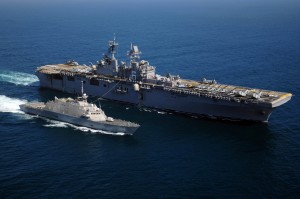 Both Steven Wills in his USNI Blog opinion piece and Chuck Hill in his response trot out some interesting numbers in support of diametrically opposed positions on the survivability of LCS. According to Wills, the US Navy lost ships under 3400 tons at a much higher rate than larger vessels in WWII. Hill looks at the numbers and comes to the opposite conclusion. The debate reminds me of the recent statistical dustup over the Patriots’ propensity to fumble that has accompanied Deflategate. And the numbers are just about as meaningful.
Both Steven Wills in his USNI Blog opinion piece and Chuck Hill in his response trot out some interesting numbers in support of diametrically opposed positions on the survivability of LCS. According to Wills, the US Navy lost ships under 3400 tons at a much higher rate than larger vessels in WWII. Hill looks at the numbers and comes to the opposite conclusion. The debate reminds me of the recent statistical dustup over the Patriots’ propensity to fumble that has accompanied Deflategate. And the numbers are just about as meaningful.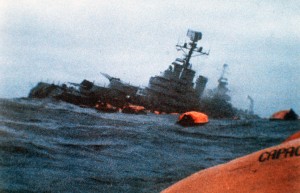 The most significant figure in the WWII ship loss data is zero. That’s the number of ships lost to anti-ship cruise missiles. While it’s tempting to try to draw equivalencies between threats in WWII and threats today, the simple fact is that war at sea looks different today than it did then. The Falklands campaign, in which the Royal Navy lost two ships (a 5,000 ton destroyer and a 15,000 ton logistic ship) to Exocet missiles, and another five vessels (one LCU, two Type 21 frigates of 3,290 tons, a destroyer of 5,000 tons, and an auxiliary of 6,000 tons) to aerial bombs, may provide a more relevant frame of reference. British ship losses in the Falkland campaign totaled two of 15 frigates and two of 12 destroyers or larger. While these numbers are helpful, it’s worth remembering the facts behind the data: the RN were limited in their mobility by the need to protect the landing force; the Argentinians were operating at the outer limits of their range, limiting the duration of engagements. And with such a small sample, it’s risky to draw too-strong conclusions.
The most significant figure in the WWII ship loss data is zero. That’s the number of ships lost to anti-ship cruise missiles. While it’s tempting to try to draw equivalencies between threats in WWII and threats today, the simple fact is that war at sea looks different today than it did then. The Falklands campaign, in which the Royal Navy lost two ships (a 5,000 ton destroyer and a 15,000 ton logistic ship) to Exocet missiles, and another five vessels (one LCU, two Type 21 frigates of 3,290 tons, a destroyer of 5,000 tons, and an auxiliary of 6,000 tons) to aerial bombs, may provide a more relevant frame of reference. British ship losses in the Falkland campaign totaled two of 15 frigates and two of 12 destroyers or larger. While these numbers are helpful, it’s worth remembering the facts behind the data: the RN were limited in their mobility by the need to protect the landing force; the Argentinians were operating at the outer limits of their range, limiting the duration of engagements. And with such a small sample, it’s risky to draw too-strong conclusions. 
